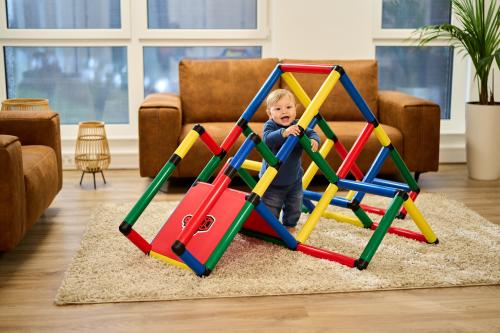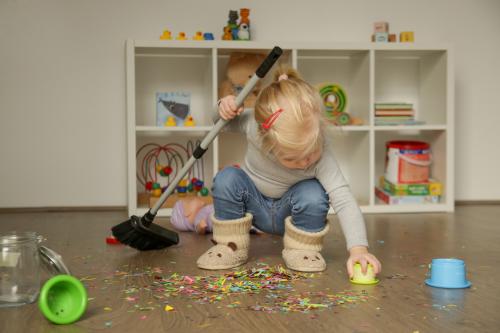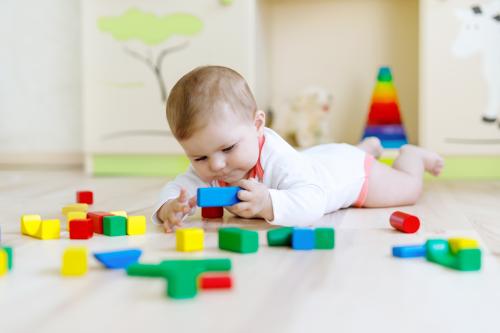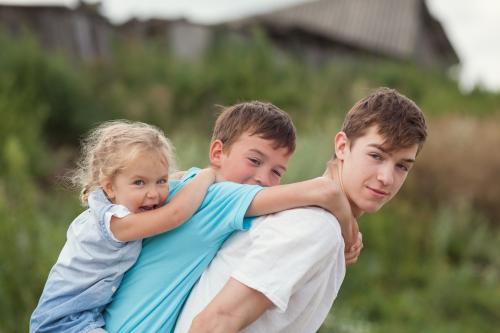The sensitive phase of movement
A child between the ages of 0 and 3 is particularly sensitive to movement; it has an urge to move: This ranges from the simple movement of the arms in the cradle, the palpation of objects, the movement of the mouth when making sounds, crawling, walking or running to more difficult hand and finger movements. All of this should be made possible for him in any case and movement should be encouraged by giving him the freedom to move wherever he wants (what this can look like at home in concrete terms, we'll go into in another article coming soon).
Children imitate their parents - in everything they do. Even little tots like to clean and sweep and do this - like many other activities - meticulously. That is why learning materials with exercises of daily life are part of a Montessori nursery. The children do all kinds of practical and useful things and have a lot of fun doing them. Along the way, they realize that they are able to perform the same activities as their parents.
In addition to an outdoor area with a playground, which should be part of a children's home, where the children can ride around on tricycles or pedal cars, and trips to a nearby forest or park, the large complex of movement also includes the simple activities: pouring from one container to another, for example. Younger children first pour sand and rice back and forth, then later water, practicing their movement coordination.

If you do not allow children this movement, it has not only physical, but also mental-intellectual consequences (more on this in the article "Couch Potatos - Why a Lack of Exercise Is Even Worse for Children than Adults").
The sensitive phase of tidiness
Much to the chagrin of parents, tidiness does not mean that children are particularly fond of cleaning up their rooms and not leaving things lying around during this time. On the one hand, it is about a temporal order: a certain daily routine, rules, structures and rituals. Teeth are brushed after meals, a story is read before bedtime. - But also around concrete times, in which the meals are taken and thus around predictability.
Also the spatial order is meant: Many things in the house have their firm place. This can also apply to the seating arrangement in the corner of the couch: If a visitor suddenly sits in mom's place, the child can get into a tizzy until the grievance is resolved (provided the parties involved recognize the connections). Something similar can happen if things are not put back in their predetermined place. The child needs this order; it is very important to him and gives him support, even if the rituals and rules differ from family to family. That is why all learning materials have their fixed place in the Children's House.
Even at home, you should encourage the child to keep his room in order: Putting toys away before getting new ones. But also the toys themselves should be neatly placed on the shelf and not simply stowed away in a large toy box; because then it can happen that the child loses interest.

If you promote this order, this will help the children later, when it comes to mathematics, very much; there, the topic of order namely also plays an important role. That's why parents should also be role models here: if they don't put their own things away, they can't expect their children to do so either.
The sensitive phase of language
"Gaga, dadadaaa. Look, there's a bow-wow!" - Adults often speak to children in a highly simplified, onomatopoeic language because they do not consider their mental capacities to be very high. Maria Montessori did not think much of this, since it was a mere mimicry of a child's vocalizations, which were not yet fully successful. In one of her writings she quotes the observation of Belgian psychologists that children at the age of two to two and a half years know about two to three hundred words, whereas four years later there are already thousands of words that the child has acquired quite spontaneously, without instruction. Now, having accomplished this feat, the child is sent to a school so that someone there will teach him the alphabet.
And in fact, the age up to four is the period after which a child masters a language so perfectly that later it will hardly be possible without lessons. And it does so all by itself - when it first listens to adults for a very long time during the sensitive phase of language before it begins to speak itself.
Second subphase: 3 to 6 years
At the age of 3, a completely new phase begins again for the child: the unconscious learning and absorbing of impressions becomes a conscious one. At this time, the child enters kindergarten. It is as if life begins anew at this point.
Now everything that is anchored in the child's subconscious is processed and made conscious. The child is in the process of perfecting his abilities. In the children's house, this happens mainly through the "sensory materials", that is, exercise materials that are didactically prepared and appeal to different senses.
Maria Montessori worked out a great many precisely thought-out materials for this phase, because she was of the opinion that ordinary toys were largely useless, and that the child instead needed something that stimulated its intelligence. It is for this and for her insights into this phase of the child's development that Maria Montessori is world-famous, and it is here that she achieved fame in the field of education.

In this phase of life, the child is particularly sensitive to social interaction: it makes friends and enters into social bonds.
Children aged 6 to 12 years
At 6 years, a child enters a new phase of life, something new begins at this point. It is not by chance that compulsory schooling takes effect from this age. The phase is not a seamless continuation of the previous one.
Children have a great hunger for education at this age, no longer indulge in individual knowledge, but want to recognize connections and causes and gain an overview. In addition, they are increasingly able to abstract; their imagination is enormous. Thus, the learning content can move from the concrete to the abstract.
In this phase, children should be introduced to as many different areas as possible. Which of them actually arouse their interest - perhaps only in later years - will turn out. The little explorers should work out the respective topics as actively as possible, because only then will they understand from the ground up how something works and have a genuine interest.

Unfortunately, this does not happen in regular school: the children do not discover things that they would come up with on their own, but those that the teacher wants them to discover. The material is mostly presented and passively consumed by the children (see also the article "Learning Has to Become Awesome" - of Finger Games and Laptops). Moreover, they learn many things in school that have no relevance to the reality of their lives. This is different at Montessori schools. In Europe, a mixed form often prevails there: between free learning and a timetable that covers certain subjects.
In this phase of life, children begin to distance themselves from their parents. Inside of them grows the need to gradually leave the narrowly defined family sphere. It becomes important to form their own opinions. At this age, in addition to sports and other community recreational courses, the Boy Scouts are an ideal leisure activity for children, because there they find a community that experiences things, does useful tasks and moves a lot in the fresh air.
Children ages 6 to 12 increasingly develop a moral sensibility and an awareness of good and evil.
Children ages 12 to 18
Like the first stage of child development, the third is a formative one: the child slowly becomes an adult. It is a time of upheaval and reorientation.
This phase is marked by freedom and independence, even if we as parents regret that our children are becoming increasingly independent of us. But for an adolescent to develop independently, to get to know himself and to find himself, his parents must give him enough freedom and not tie him too closely to the family.
The teenager takes his first steps on the social stage. Peers become more important, whether as comrades from the sports club, in the band where the teenager plays music, or in the circle of friends. A sense of "we" develops. The adolescents form their own opinion, stand up for it, oppose the adults - especially parents and teachers.
At the same time, however, this is also an unstable and restless phase in which the adolescents undergo major psychological changes. They are still insecure, doubt themselves, sometimes show fears. In addition, they develop compassion for their fellow human beings during this time, become caring.
For this phase of child development, Maria Montessori worked out the "Earth Child Plan". Her idea was to release children into adult life who not only are smart, but can also tackle it. And vice versa. This can be described as "learning with head, heart and hand".
In this context, the reform pedagogue devised a kind of boarding school, which included a farm, a farm store and a restaurant, which on the one hand were to teach how to deal with money, but also how to act economically. The young people learned about economic processes there. In addition, they became self-supporters in this way. They organized themselves, everyone took over services in the house and all got a good view of the ecology.

The young people thus maintained a sustainable lifestyle even then, pursued productive work in nature and met the challenges that real life posed to them - in contrast to their peers at regular schools, who solved tasks at their desks that someone had thought up for them. Montessori students learned about life in the community, detached from their parents.
Till today, some such boarding schools exist. In the U.S., some adapted to the prevailing conditions and invented the "urban compromise": students attend a school in the city, but leave it time and again to spend some time in the countryside and work there.
Polarization of Attention
What Maria Montessori called the "polarization of attention" became known as the "Montessori Phenomenon." She describes the key experience of this in her works: she observed a girl completely absorbed in her activity (putting a wooden cylinder into a hollow); she repeated the procedure countless times, and allowed nothing to disturb her, even when Maria Montessori tried: She tried to disrupt the girl's activity or distract her with something, without success. Only when the girl had put the cylinder into the opening 44 times did she look up again, happy and satisfied.
What Maria Montessori had experienced here contradicts what we adults know and strive for: We want to save time in everything we do, so we try to do it as efficiently as possible. The child, on the other hand, never tires of repeating an action - and takes it very seriously. In doing so, it trains its senses, exercises its skills, and is more enthusiastic about the task the more difficult the challenge seems (while still being manageable).

This concentration on one thing was a central aspect of learning for Maria Montessori, especially since children are otherwise rather lively and restless, running around and jumping from one activity to another. But how does one achieve this concentration? Similar to adults who get into the flow while jogging or mountain climbing, or scientists, researchers, and artists who are completely absorbed in what they are doing: They all chose what they do themselves and enjoy doing it.
So you should also let the child choose what it wants to occupy itself with - as is the case in Montessori children's homes. Because this kind of concentration happens out of an inner drive and cannot be forced. What is important is that the child finds what it wants to occupy itself with in his environment and that there is a trusting atmosphere where it "gets to work".
Then a deep form of concentration occurs, which almost takes on a meditative character through the many repetitions - like a dance in a trance. The child should not be disturbed thereby, even not by feedback, which might be positive - we adults do not like it likewise, if someone looks us over the shoulder. While the child pursues his activity, time stops; its sense of time has changed. In this concentrated activity, all negative feelings disappear, they are faded out - like the rest of the environment.
Only when the child has reached an inner saturation, it interrupts what it has been doing all the time, lets the impressions sink in, reflects on what it has experienced - the newly acquired knowledge and skills are processed unconsciously. Then is the time to look for a new activity.
If children experience this polarization of attention again and again anew, they are inwardly balanced and strengthened, rest in themselves. Inner silence counteracts the overstimulation that is becoming more and more common today and leads to mindfulness of one's surroundings.
Maria Montessori had developed an exercise in this context: With the help of masking tape, she stuck a large circle on the floor. The children should go one after the other on the line. After a short time, the children automatically matched their steps to each other. Later, each got a bell in the hand and should go on the line so that it did not disturb the others with it, so had to be particularly attentive.
Even in our time such exercises are particularly meaningful - because the majority is just no longer mindful. One thinks thereby of the loud telephoning in public transport, the ungentle slamming of doors in the stairwell, where one could be also quiet, if one uses the key. Consideration has become increasingly rare. Therefore, it is good if these behaviors are practiced in early childhood, when polarization of attention most often occurs.
It's all about touch
In Jesse McCarthy's "Montessori Education Podcast," Meredith Narrowe, who spent eight years of her life in a Montessori facility, talks about having many tactile experiences there. She was there from the age of 2 and remembers a great many details from her early years in the children's home, whereas Jesse McCarthy, thinking of his early kindergarten and school years, has few memories of them. The reason for the difference may be due to the sensory experiences that one had while the other did not.

Recent research in the field of neuroscience shows that we learn much better with movement than without it. And movement doesn't just mean sports and running around in the playground, but also the fine motor movements of the hands. Hands are overrepresented in our brain. So just the learning, in which the hands are involved, is brain-friendly.
Tell me and I will forget, show me and I may remember; involve me and I will understand.
Confucius (551-479 B.C.)
Montessori acknowledged this principle. She noticed people often move their hands while thinking—scratching their temples, rubbing their chins, or gesticulating during a lecture. Therefore, Montessori developed sensory materials that stimulate various senses, especially touch, to help children understand their world better. It has been found that children retain 80 percent of what they do compared to only 20 percent of what they read.
Nothing is in the intellect that did not originate in the senses.
John Locke, 1632-1704
Children who try things for themselves quickly discern their strengths and areas of improvement. This type of learning also ensures that facts discovered independently are better remembered. Children are also more likely to eat a meal they prepare themselves than one made by others.
It's the technology, stupid!
Is early exposure to technology beneficial for children developing independence? The answer to this question is no. Children who first interact with a computer at six years old are still early enough in their technological journey. Computers do not count as didactic materials; they do not provide key experiences but serve as mere tools.

Simone Davies, a Montessori podcaster, and author, suggests that technology should not completely be excluded from children's lives. For instance, video conferencing with distant grandparents or limited time on a computer is acceptable. However, she warns against replacing traditional learning methods (for more on this topic, see the article "Learning Has to Become Awesome - of Finger Games and Laptops") with digital ones, as it can have detrimental effects on a child's development.
Self-reliance
"Help me to do it myself," a famous phrase associated with Montessori education, originated from a child's request to Maria Montessori. Observing children reveals that they rarely intervene when another child struggles with a task unless absolutely necessary. In contrast, adults often inhibit their children by assisting them in tasks they can essentially handle on their own. Encouraging self-reliance boosts the child's confidence and shows respect for their capabilities.

This approach yields impressive results. For instance, William Kelly, an eleven-year Montessori veteran, shared an experience where he and his sixth-grade classmates planned and organized a trip to New York. The students thoroughly prepared, researched, and made bookings independently, a testament to the lasting impacts of the Montessori education system.
Freedom and Structure
One common misconception about Montessori schools and children's houses is that they are environments of uncontrolled chaos or anarchy, where children can do as they please. However, this couldn't be further from the truth. Montessori schools do not provide an unrestricted license to engage in any activity, nor do they resemble democratic schools as we depicted in our article "Actually, I Really Like School". There is no randomness in these environments. Each child's freedom is balanced against the need to respect the freedom of others and the common good. This can be seen as a sort of structured freedom.
The balance between unrestricted activity and collective experience is the essence of the institutions' approach. Children have periods of free work, where they can pursue their interests, and shared experiences, such as group readings and discussions. Each child has autonomy over aspects of their day, such as what they would like to eat or do during free work. This philosophy stems from the understanding that true learning is always self-directed.
Children can also choose how often they wish to repeat an activity. The more repetition, the greater the sense of achievement. Once they feel they've mastered a task or quenched their curiosity, they autonomously decide on the next activity. This could range from observing their peers to watching leaves fall from a tree in the autumn. All choices are considered legitimate.
At school, when faced with tasks, children are free to determine their method of problem-solving. This approach accommodates different learning styles: auditory learners might benefit from repeated explanations, visual learners might prefer reading, and social learners might gain the most from group discussions. Regardless of the method, Montessori institutions cater to all learning styles. If questions arise, they are addressed immediately rather than waiting for their relevance in the curriculum.
Children also have autonomy over their learning environment. They may choose to learn alone, with a partner, or in a group, and they may work at a desk, on a mat on the floor, in a hallway, or even outdoors.

Despite this freedom, Montessori environments are disciplined. There's no unruly behavior or excessive noise. Children are deeply engrossed in their activities, taking responsibility for their own education and life. They operate based on an "inner teacher," akin to an "inner doctor" guiding us through a self-healing process.
Building the Self
Maria Montessori posited that every child carries an innate blueprint, distinct from their genetic one, that guides the development of their self. Thus, her pedagogy was designed to help life: each child can be true to their identity and find it through their experiences. The fundamental belief of Montessori schools is that each child is unique. The emphasis is on understanding and responding to a child's needs rather than labeling their behavior.
Creativity
Montessori education, by offering children autonomy in learning, fosters creativity—a critical skill in today's world (compare the article "Two Plus Three Is Purple"). Decision-making itself is a complex creative process. When decisions don't yield the desired outcome, children must creatively seek alternative solutions. This ability to overcome challenges equips them for adult life.
Solving problems can become a rewarding process. When children develop an affinity for it, they actively seek out challenges and continually improve their problem-solving skills. Creativity blossoms when adults give children time to develop their own ideas.
Parents sometimes worry that a Montessori education might cause their child to develop one-sidedly or miss out on essential skills. A case in point was when a six-year-old showed no interest in reading at the Montessori institution "Les Petits Montessoriens" in France. After considering whether to intervene or trust the child's pace, a balanced approach was chosen. In time, the child learned to read, much to everyone's relief.
Parents, however, must realize that educational institutions don't absolve them of their responsibility towards their child. Institutions can't replace the parental duty of making decisions based on their child's wellbeing and needs.
Joy of Discovery
The fruits of Montessori education are evident in the life of Meredith Narrowe, who was immersed in Montessori learning from the ages of two to ten. She recounts her journey in the "Montessori Education Podcast". Her childhood learning was continually spurred on by a delight in discovery, a joy that eventually led her to Stanford University, and beyond.

One day, she watched the animated movie "Finding Nemo". She loved it, but also recognized that none of the elements in it were random. Her curiosity was ignited. She started wondering: how does this work? She wanted to know everything about it. That interest propelled her into a career in animation. Jesse McCarthy, the host of the podcast, encapsulates the Montessori principle in that episode as "The why never dies." Montessori children - who later grow into adults - consistently question the phenomena they encounter in life, their unquenchable curiosity serving as a driving force for continual knowledge acquisition."
Mixed-age Learning
Another misconception is that Montessori education, being an alternative form of learning, is not for everyone. However, Katy Wright argues that Montessori's individualized learning should ideally suit all children. Conventional schools often impose a uniform pace of learning, leading to frustration or boredom. Montessori's approach allows each child to work at their own pace, aligning with their developmental stage.
Wright advocates using pediatric age ranges to guide school expectations. Age shouldn't be the primary criterion in education; skills should. Outside of school, children interact with a variety of age groups, from sports clubs to family settings. Only in school are children segregated by age.
The mixed-age approach of Montessori schools offers several advantages: children of different ages can learn from each other, fostering a cooperative learning process.
Diversity
A hallmark of Montessori classrooms is the diversity they foster, marked by children with varying abilities, strengths, and weaknesses. This diversity stems partly from the age differences within the classroom. Children learn to view differences not as a disadvantage, but as a norm. They learn to accept different abilities, paving the way for the integration of children with disabilities as well as the gifted ones into the learning process.
Moreover, faster learners are not held back waiting for a new grade to acquire fresh knowledge; they can proceed immediately. On the other hand, slower learners are not forced to repeat a grade but can stay with the group until they too have mastered the necessary knowledge. This principle allows Montessori schools to accommodate the increasing heterogeneity of their student body.
The age mix encourages numerous opportunities for cooperation, mutual assistance, and consideration. It cultivates a sense of tolerance in children. As new, younger children join, the groups not only gain new energy but also allow children to experience different roles: the youngest, the middle, and the eldest. This cycling of roles ensures that no child is stuck in a particular role, whether it's the outsider or the class favorite, always offering the opportunity for change.
Benefits for Younger Children
William Kelly's key Montessori experience as a three-year-old is instructive: he witnessed a two-year-old reading aloud from a book to him and others. The young audience was captivated and inspired to learn to read.
Age-independent groups play a critical role because younger children keenly observe and emulate the older ones. As a result, they are exposed to interesting tasks and receive plenty of inspiration. Sometimes, they even learn things that are typically reserved for older children. Kelly himself had the opportunity to learn from the older grades at the Montessori children's house, where his questions were always warmly received and answered by the group leaders.

Another advantage for younger children is that they often better understand the explanations given by older children, as their language and thought processes are closer to their own. At the Jeanne d'Arc School in Roubaix, France, it is customary for older children to orient newcomers to the school environment. This guidance helps new children adjust swiftly, with no need for teacher intervention.
Benefits for Older Children
One might presume that older children derive no benefits from the age mix, as they are already capable of handling most tasks. However, they too benefit significantly from assisting the younger ones, and not just in terms of developing empathy and social skills. As they pass on their skills, they build self-confidence, gain a sense of maturity interacting with younger peers, and assume protective roles, thus fostering responsibility. Moreover, they discover questions they hadn't previously considered. As they explain concepts, new questions inevitably arise, leading to a deeper exploration of knowledge that benefits both them and their younger peers.
A child explaining something to a younger peer has learned to share knowledge, an essential skill in our society. They have learned to communicate, to recognize their progress, and to consolidate their understanding. We often learn best when we explain the same facts to someone else. In doing so, we can ascertain whether we've fully grasped the concept.
Children who are less confident or struggle with learning have the opportunity to reinforce their knowledge by teaching others without the pressure of formal academic settings.
The third part of our article delves into why children acquire vital skills through the Montessori method.
Please refer to the end of Part 3 for all sources.

Comments